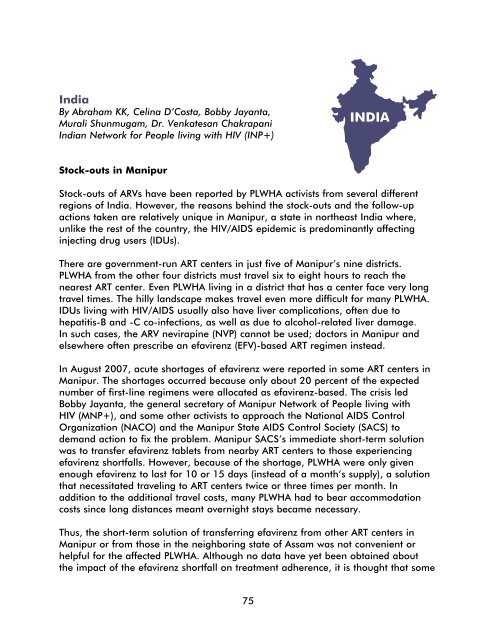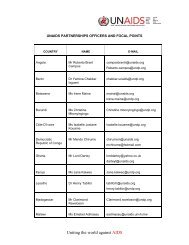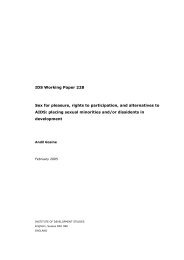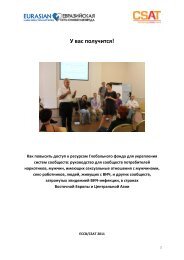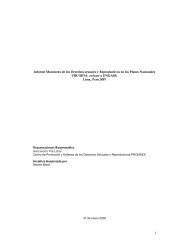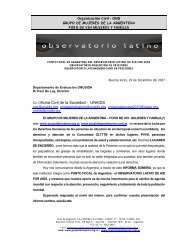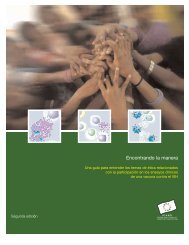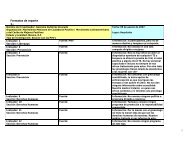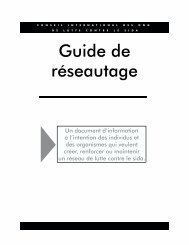Missing the Target #5: Improving AIDS Drug Access ... - CD8 T cells
Missing the Target #5: Improving AIDS Drug Access ... - CD8 T cells
Missing the Target #5: Improving AIDS Drug Access ... - CD8 T cells
Create successful ePaper yourself
Turn your PDF publications into a flip-book with our unique Google optimized e-Paper software.
IndiaBy Abraham KK, Celina D’Costa, Bobby Jayanta,Murali Shunmugam, Dr. Venkatesan ChakrapaniIndian Network for People living with HIV (INP+)Stock-outs in ManipurStock-outs of ARVs have been reported by PLWHA activists from several differentregions of India. However, <strong>the</strong> reasons behind <strong>the</strong> stock-outs and <strong>the</strong> follow-upactions taken are relatively unique in Manipur, a state in nor<strong>the</strong>ast India where,unlike <strong>the</strong> rest of <strong>the</strong> country, <strong>the</strong> HIV/<strong>AIDS</strong> epidemic is predominantly affectinginjecting drug users (IDUs).There are government-run ART centers in just five of Manipur’s nine districts.PLWHA from <strong>the</strong> o<strong>the</strong>r four districts must travel six to eight hours to reach <strong>the</strong>nearest ART center. Even PLWHA living in a district that has a center face very longtravel times. The hilly landscape makes travel even more difficult for many PLWHA.IDUs living with HIV/<strong>AIDS</strong> usually also have liver complications, often due tohepatitis-B and -C co-infections, as well as due to alcohol-related liver damage.In such cases, <strong>the</strong> ARV nevirapine (NVP) cannot be used; doctors in Manipur andelsewhere often prescribe an efavirenz (EFV)-based ART regimen instead.In August 2007, acute shortages of efavirenz were reported in some ART centers inManipur. The shortages occurred because only about 20 percent of <strong>the</strong> expectednumber of first-line regimens were allocated as efavirenz-based. The crisis ledBobby Jayanta, <strong>the</strong> general secretary of Manipur Network of People living withHIV (MNP+), and some o<strong>the</strong>r activists to approach <strong>the</strong> National <strong>AIDS</strong> ControlOrganization (NACO) and <strong>the</strong> Manipur State <strong>AIDS</strong> Control Society (SACS) todemand action to fix <strong>the</strong> problem. Manipur SACS’s immediate short-term solutionwas to transfer efavirenz tablets from nearby ART centers to those experiencingefavirenz shortfalls. However, because of <strong>the</strong> shortage, PLWHA were only givenenough efavirenz to last for 10 or 15 days (instead of a month’s supply), a solutionthat necessitated traveling to ART centers twice or three times per month. Inaddition to <strong>the</strong> additional travel costs, many PLWHA had to bear accommodationcosts since long distances meant overnight stays became necessary.Thus, <strong>the</strong> short-term solution of transferring efavirenz from o<strong>the</strong>r ART centers inManipur or from those in <strong>the</strong> neighboring state of Assam was not convenient orhelpful for <strong>the</strong> affected PLWHA. Although no data have yet been obtained about<strong>the</strong> impact of <strong>the</strong> efavirenz shortfall on treatment adherence, it is thought that some75


